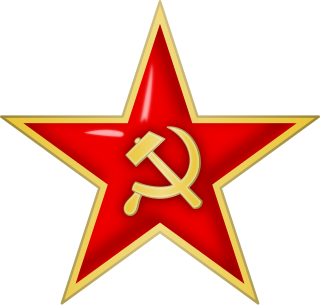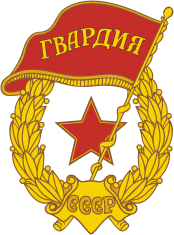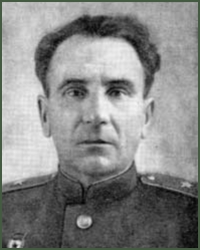
The Western Front was a front of the Red Army, one of the Red Army Fronts during World War II.
The 16th Army was a Soviet field army active from 1940 to 1945.
The 22nd Army was a field army of the Red Army during World War II.
The Separate Coastal Army, also translated to English as Independent Coastal Army, was an army-level unit in the Red Army that fought in World War II. It was established on July 18, 1941, by the order of the Southern Front from the forces of 9th Army’s Coastal Group and was stood up on July 20, 1941.
The 30th Army was a Soviet field army of the Red Army active between 1941-1943. It was re-organised to the 10th Guards Army on 16 April 1943.

The 3rd Guards Volnovakha Red Banner Order of Suvorov Motor Rifle Division was a division of the Soviet Army from 1957 to around 1992. It traced its history from the highly decorated 3rd Guards Rifle Division of World War II. 3rd Guards Rifle Division was formed from the 153rd Rifle Division.

The 20th Army was a field army of the Red Army that fought on the Eastern Front during World War II.
The 39th Army was a Field Army of the Soviet Union's Red Army during World War II and of the Soviet Army during the Cold War.

The 28th Army was a field army of the Red Army and the Soviet Ground Forces, formed three times in 1941–42 and active during the postwar period for many years in the Belorussian Military District.
The 220th Rifle Division was briefly a Red Army motorized infantry division that was re-organised shortly after the German invasion as a standard rifle division. It managed to avoid destruction during Operation Typhoon, but only its 653rd Rifle Regiment remained battleworthy through the winter. Once rebuilt it took part in the fighting around Rzhev in 1942 and then in the follow-up to the German evacuation of the salient in the spring of 1943. When the summer offensive toward Smolensk began in August it was part of Western Front's 31st Army and it remained in this Army almost continuously for the duration of the war. During the following autumn and winter it took part in the Front's increasingly futile offensives on Orsha, but in the first stages of the Destruction of Army Group Center it assisted in the liberation of that town and was awarded its name as an honorific; its rifle regiments soon also gained honors for the liberation of Minsk. Less than two weeks later it also shared credit for the liberation of the city of Grodno and was awarded the Order of the Red Banner while several of its subunits were recognized for successfully crossing the Neman River nearby. After the abortive offensive into East Prussia in October it contributed to the capture of that province in early 1945 before being moved to 1st Ukrainian Front in April, and it ended the war in Czechoslovakia. Despite its solid combat record it was disbanded during the summer.

The 331st Rifle Division was formed as an infantry division of the Red Army in the summer of 1941, based on a cadre of volunteer workers and reservists from the Bryansk Oblast, and so was known from the beginning as the 331st Bryansk Proletarian Rifle Division. It fought to defend Moscow during the last stages of the German invasion, and then went over to the offensive in early December. It spent much of the next twelve months in the same general area, west of the capital, taking part in the mostly futile battles against the German-held salient at Rzhev. On September 25, 1943, the division shared credit with several other units for the liberation of the city of Smolensk and was given its name as an honorific. The 331st had a highly distinguished career as a combat unit, ending its combat path in Czechoslovakia, advancing on Prague.

The 334th Rifle Division was formed in August 1941, as a standard Red Army rifle division in the Volga Military District. For most of the war it followed a very similar combat path to that of the 332nd Rifle Division, sometimes serving on adjacent sectors. It fought in the Battle of Moscow and during the winter counteroffensive was assigned to 4th Shock Army, where it would remain until November 1943. During this offensive it helped carve out the Toropets Salient, where it would remain until the autumn of 1943 when it helped to liberate Velizh and began advancing westward again. In the first days of the 1944 summer offensive the 334th shared credit with several other units in the liberation of Vitebsk and was awarded that name as an honorific. The unit advanced into East Prussia in January 1945, distinguishing itself in the siege of the heavily-fortified city of Königsberg and the clearing of the Baltic coast. It continued to serve briefly into the postwar period.
The 19th Guards Rifle Division was formed from the first formation of the 366th Rifle Division on March 17, 1942. At this time it was in the 52nd Army of Volkhov Front, taking part in the Lyuban Offensive Operation, which was planned to encircle and defeat the enemy forces laying siege to Leningrad. However, just at that time the German 18th Army was in the process of cutting off the Soviet Lyuban grouping in a pocket, and over the following months the division was nearly destroyed. Enough survivors emerged from the swamps in June and July to rebuild the unit, and it fought in the Second Sinyavino Offensive before it was shifted south into Kalinin Front to take part in the battle and siege of Velikiye Luki in December. In the summer of 1943 the 19th Guards fought in the battles for Smolensk, and won its first battle honor, "Rudnya". in September. During the offensive in the summer of 1944 it was awarded the Order of the Red Banner for its successes in the fighting around Vitebsk. It was further honored in February, 1945, with the Order of Lenin for its role in the victories in East Prussia. In the summer the division was moved by rail with its 39th Army to the Far East and saw action in the Soviet invasion of Manchuria in August, winning its second battle honor, "Khingan", for its services. The division continued to see service well into the postwar era.
The 371st Rifle Division was raised in 1941 as a standard Red Army rifle division, and served for the duration of the Great Patriotic War in that role. It began forming in August 1941 in the Urals Military District. It was soon moved to the front lines near Moscow, and took part in the counteroffensive that began on December 5. It spent all of 1942 and the first months of 1943 in the fighting around the Rzhev salient, and after a short break served in the offensive that liberated Smolensk. After a winter of brutal combat on the approaches to Orsha and Vitebsk it was reassigned to 5th Army in 3rd Belorussian Front and took part in Operation Bagration, during which it was recognized for its role in the liberation of the latter city with a battle honor. The division was further distinguished in late July with the Order of the Red Banner for its part in the liberation of Vilnius. In January 1945, it fought its way into East Prussia, and as that campaign was winding down it was moved across Asia, along with the rest of 5th Army, to take part in the campaign against the Japanese Kwantung Army in Manchuria.
The 381st Rifle Division was raised in 1941 as an infantry division of the Red Army, and served for the duration of the Great Patriotic War in that role. It began forming in August, 1941 in the Urals Military District. It first served in the bitter fighting around the Rzhev salient, deep in the German rear in the 39th Army and came close to being completely destroyed in July, 1942. The division's survivors were moved north well away from the front for a major rebuilding. It returned to the front in October, joining the 3rd Shock Army for the battle and siege of Velikiye Luki. The division remained in this general area in western Russia until March, 1944, when it was moved to the Reserve of the Supreme High Command and then to 21st Army north of Leningrad in April. It served in the offensive that drove Finland out of the war from June to September, winning a battle honor and the Order of the Red Banner in the process, before being transferred back to the Soviet-German front in October. As part of the 2nd Shock Army of 2nd Belorussian Front the 381st advanced across Poland and Pomerania during the winter of 1945, then joined its Front's advance across the Oder River into north-central Germany in late April, ending the war on the Baltic coast. In the summer of that year the division was disbanded.
The 88th Rifle Division was twice formed as an infantry division of the Red Army, first as part of the prewar buildup of forces. In its first formation in the far north it had an unusual shtat probably to facilitate its movement in the roadless tundra and forests of that region. During the Winter War against Finland it saw action in the fighting around Salla. Its organization again proved beneficial in the spring of 1942 during the first stages of the Great Patriotic War. It played a large role in holding and then pushing back the Finnish III Army Corps during Operation Silver Fox and for this success was redesignated as the 23rd Guards Rifle Division.
The 91st Guards Rifle Division was reformed as an elite infantry division of the Red Army in April 1943, based on the 2nd formation of the 257th Rifle Division, and served in that role until after the end of the Great Patriotic War. It ended the war in the far east of Asia following the Soviet invasion of Manchuria with a highly distinguished record.
The 214th Rifle Division was an infantry division of the Red Army, originally formed in the months just before the start of the German invasion, based on the shtat of September 13, 1939. It was moved to the fighting front to join 22nd Army in late June and took part in the fighting between Vitebsk and Nevel in early July, escaping from encirclement in the process, and then played a significant role in the liberation of Velikiye Luki, the first Soviet city to be retaken from the invading armies. In October it was again encircled near Vyasma during Operation Typhoon and was soon destroyed.
The 222nd Rifle Division was an infantry division of the Red Army, originally formed in the months just before the start of the German invasion, based on the shtat of September 13, 1939. It was formed at Starodub and was considered a "sister" to the 217th Rifle Division. It first saw action in July 1941 as part of 28th Army in the fighting between Smolensk and Roslavl and the division took heavy casualties when it was partly encircled and forced to abandon the latter city in early August. It was again encircled during Operation Typhoon but managed to escape complete destruction and soon came under command of 33rd Army, where it remained for almost the entire length of the war.
The 229th Rifle Division was an infantry division of the Red Army, originally formed in the months just before the start of the German invasion, based on the shtat of September 13, 1939. As part of 20th Army it was moved from the Moscow Military District to the front west of Orsha by July 2. Serving under Western Front the 20th was soon pocketed in the Smolensk region but the 229th was able to escape at the cost of significant losses. It was partially rebuilt before the start of the final German offensive on Moscow when it was completely encircled and destroyed.





